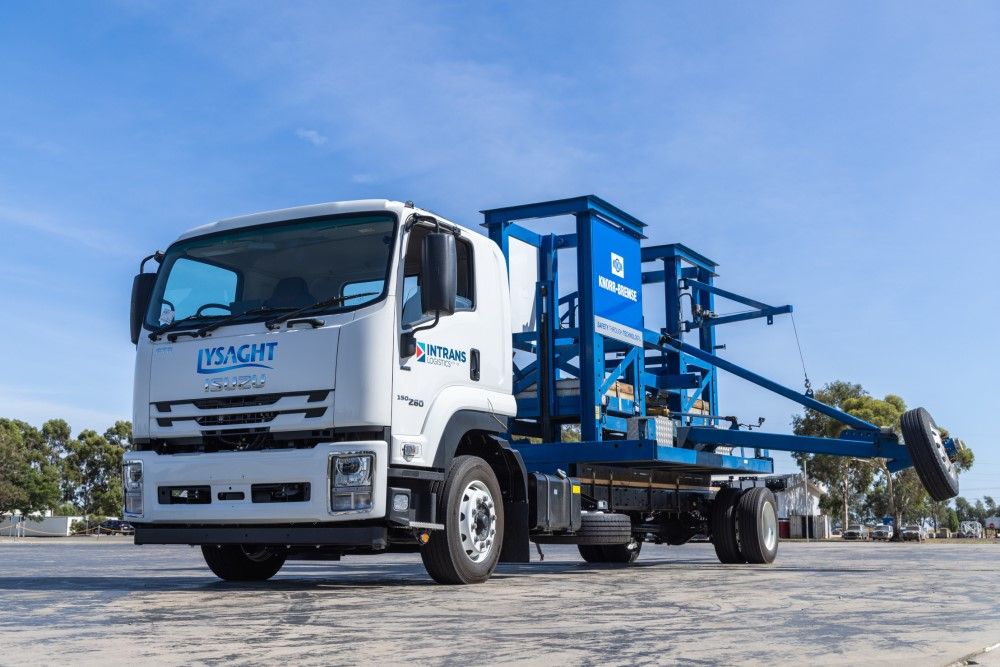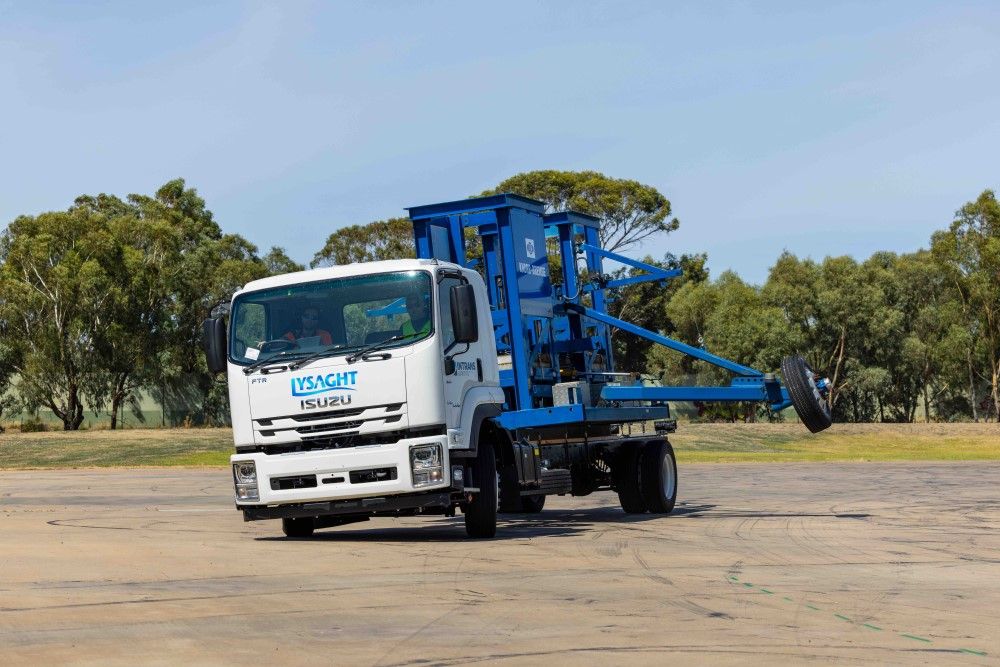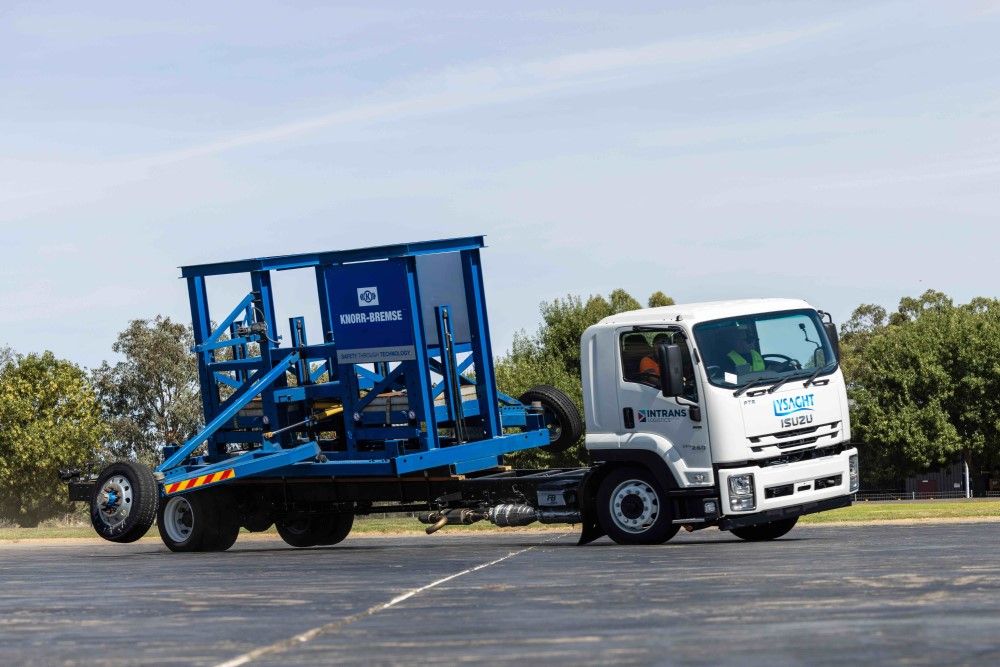
Local Safety Test Hits Home for Isuzu
Isuzu Australia has extended its rigorous round of Australian-tuned electronic stability control testing with control and brake system specialist Knorr-Bremse on location in Shepparton, Victoria.
The local test and tuning is in addition to the requirements of the Australian Design Rules (ADR) mandates.
Isuzu said ADRs are applied to its trucks manufactured in Japan but Isuzu Australia Limited (IAL) takes further steps by conducting its own testing program on Australian home turf “to ensure we are capturing our unique conditions and the requirements of local operators during the development, proving and calibration stages.”
The latest testing used a medium-duty FTR 150-260 fitted with a customised test body which was then put through its paces to develop a new calibration for the EBS-5 control unit.
While the bulk of Isuzu’s braking componentry, development and set-up is conducted in Japan by Isuzu Motors Limited (IML) and Knorr-Bremse, our local calibration and testing program at Isuzu Australia allows for a fine tuning that’s bespoke for our road conditions, wheelbase modifications and prevailing application use.
IAL said it was important that it apply local knowledge and engineering rigour to help refine the safety technology on the trucks which it sells on the Australian market.
“It is a continued process as technology evolves, with our end goal to deliver the safest driving environment and the most fit-for-purpose on-road product to Australian businesses,” it said.

IAL said Australia’s road transport industry is under great pressure to support a growing population, from the on-road logistics of moving products and produce across the country to truck-reliant businesses that work in all manner of applications.
“Great improvements have been made recently in the comfort and efficiency of heavy vehicles used across the industry,” it said.
“But by far, some of the greatest and arguably most important advancements have come in the evolution of our safety technology, this is with regard to the technology that assists with the safety of vehicle occupants and the safety of other road users.
“Australian operators have a unique combination of factors and challenges to tackle that include operating conditions, climate and the roads themselves.
“This is of course across a vast landscape that covers greater kilometres and a much greater range of road conditions compared to most other countries on the planet.”
The truck maker said it looks at vehicle safety in two broader forms - active and passive safety.
“In past years ‘passive’ safety features were a key focus, namely the development of components such as seat belts and airbags and improving the overall construction of cabins and running gear to protect occupants,” it said.
“Since the late 1990s, IAL and many other OEMs have put a much greater emphasis on, expended more resources to conduct extensive research and testing into improving ‘active’ safety features to prevent incidents from happening in the first instance.
“This is of particular importance in our arena in the development of heavy vehicles, where even low speed accidents can have catastrophic consequences to not only driver and passengers, but other users on the road.
“Even in recent times and with improved safety measures in place, heavy trucks and buses have been involved in high-profile crashes that have ended with fatalities. The tragic event which unfolded in the Hunter Valley recently springs to mind.
“This hammers home to us at IAL—as Australia’s largest volume seller of commercial heavy vehicles—that we have an obligation to take truck safety very seriously.”
The safety program led to Isuzu collaborating with commercial vehicle braking and control systems specialists KnorrBremse which has conducted extensive ESC system testing in Japan.
“In a first for us here at Isuzu Australia and a first for any Japanese-made truck on Australian soil, we recently conducted a rigorous round of ESC testing and calibration exercises in conjunction with Knorr-Bremse Australia.” IAL said.
This was conducted at the DECA (Wodonga TAFE) testing and training facility in Shepparton in Central Victoria on a medium-duty Isuzu FTR 150-260, fitted with a test body customised for Knorr-Bremse.
This test body features flexible loading racks and extended outrigger wheels attached to the body sub-frame to enable a safe testing environment and assist with development of a new calibration for the EBS-5 control unit.
This control unit is factory-fitted to Australian-market MY22 Isuzu FTR 150-260 models and all MY22 FV models in the range, providing for an advanced ESC system.
Unique to this particular FTR model was an extended wheelbase of 7.2 metres, which is a dimension beyond that available from the factory in Japan.

It’s significant too in that this wheelbase length is the longest possible while remaining within the ADR turning circle limit of 25 metres.
To determine the new calibration, we put the truck through a series of specific manoeuvres within the controlled environment of the DECA facility.
Specialised Knorr-Bremse equipment on board the truck recorded and sent data back to the team throughout the manoeuvres.
IAL said it was important to note the types of manoeuvres undertaken by the test truck were tailored to the way in which trucks are deployed within Australian industries and applications.
“That’s not to say we believe all Aussie drivers knock along at breakneck speeds but these specific manoeuvres on the DECA skid pan helped us to simulate what a possible roll-over situation would look like on the bitumen, being operated by an Australian driver in Australian conditions,” it said.
“The ESC system being tested and calibrated would then intervene automatically for the test driver and help to prevent those incidences of rollover or loss of directional control.
“The system works by firstly removing the throttle from the driver’s control and then automatically applying appropriate braking to individual wheels to slow the truck down to a safe speed.
“As is the case with any development or proving work, especially in the road safety space, the devil is in the detail. The data collected throughout the testing was critically analysed and fed back into the programming of the EBS-5 control unit.
“The use of outriggers during this testing phase prevented any rollovers and determined the exact point at which it would happen on the test truck—but unfortunately you don’t get that type of back-up out on the open road.
“That’s why we conduct further extensive on-road testing to ensure calibrations are correct and the systems are working as they should in an everyday situation.”
Commercial vehicles are a serious investment, and getting truck finance right matters when your livelihood depends on keeping vehicles on the road. Credit One specializes in transport operators and understands what you're dealing with. As Australia's best-reviewed finance broker with 3,000+ Google reviews from operators nationwide, they've proven the approach works. Check out Credit One reviews to see for yourself, then use the loan repayment calculator to understand your options.